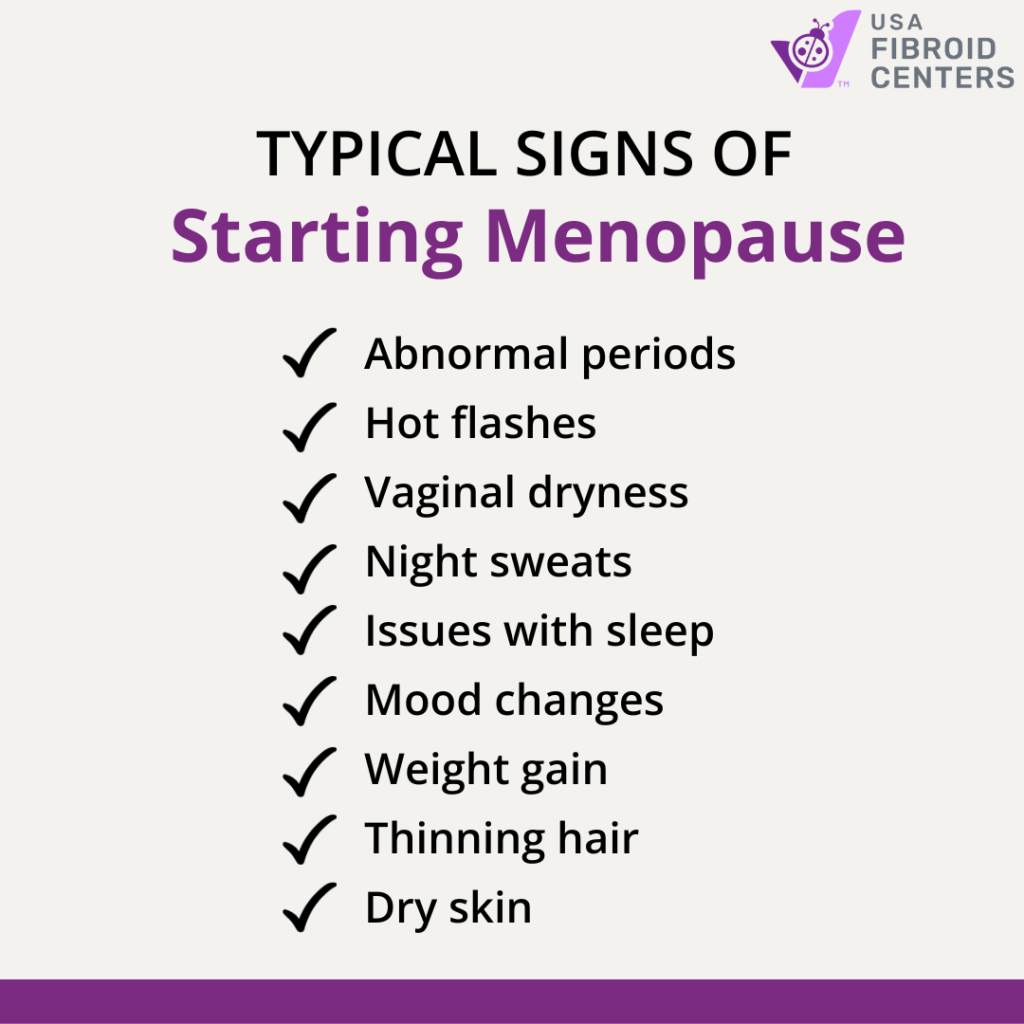
If you are experiencing symptoms of uterine fibroids, including heavy periods, painful cramps, and frequent urination, treatment solutions are available to transform your health and well-being.
Early menopause can manifest through a variety of signs, such as irregular periods, hot flashes, night sweats, mood swings, and decreased libido, significantly impacting a woman’s quality of life and fertility. Factors influencing or causing early menopause include genetics, autoimmune diseases, smoking, and certain medical treatments. Among the treatment options for uterine fibroids, which can affect a woman’s reproductive system, are surgical and non-surgical approaches. The most recognized surgical option is a hysterectomy, which involves removing the uterus and carries the risk of permanent outcomes like premature menopause and infertility. Alternatively, uterine fibroid embolization (UFE) offers a non-surgical solution that preserves the uterus, providing a viable option for those seeking to avoid the potential for early menopause and maintain their fertility.
If you are premenopausal, you may be wondering, does UFE cause early menopause? Here’s what you need to know about UFE, the long-term side effects of fibroid embolization, as well as premature menopause and fibroids.
LEARN MORE ABOUT UFE IN OUR NEWSLETTER
Fibroids and Menopause
Did you know the average age of menopause is between 45 and 55 years old and can last anywhere from 7 to 14 years?¹
Even if you are not approaching the age of menopause, it’s still important to understand what it is and its effects on your body.
Before menopause begins, your body will go through a transitional phase called perimenopause.
The belief that fibroids can be eradicated by reaching menopause is a misconception, as fibroid growth is influenced by hormonal changes. However, relying on menopause as a method for treating fibroids is not a practical approach.
The most effective way to handle fibroid symptoms is through treatment from one of our specialized interventional radiologists at USA Fibroids.
One concern some women may have about treatments such as UFE, though, is whether they can cause premature menopause, especially for women who may want children and are not approaching menopausal age.
UFE: Effective Treatment with Low Risk of Early Menopause
Uterine fibroid embolization (UFE) is highly unlikely to cause early menopause (premature ovarian failure). In fact, studies show minimal impact on ovarian function after UFE in most women. However, a very small percentage of women (less than 1%) may experience temporary or, in rare cases, permanent changes in their menstrual cycle due to reduced blood flow to the ovaries. If you have concerns about this risk, talk to your doctor to understand it in the context of your individual health and treatment options.
Your age at the time of treatment may have an impact on your risk of early menopause after UFE. Research shows that women older than 40 are at increased risk.² One study found that out of 21 women over the age of 45 who underwent UFE, only nine women (43%) went into premature menopause.³
Although premature menopause is not common after UFE for most women, getting your symptomatic uterine fibroids treated earlier decreases your chances of this occurrence.
The Importance of Working With Expert Fibroid Specialists
Some research suggests that the doctor performing the UFE and the technique used might influence the risk of irregular periods after the procedure. Having all the information to make informed decisions about your healthcare is essential.
At USA Fibroid Centers, we offer access to highly experienced interventional radiologists with extensive UFE expertise across numerous clinic locations nationwide.
Talk to a Fibroid Expert Today
What Else Should I Know About Fibroid Treatment?
Whether or not early menopause is a factor in your fibroid treatment decision, we believe it is important to know the benefits and potential drawbacks of hysterectomy and UFE.
By partnering with one of our specialists who understand fibroids, you can confidently explore different treatment options and choose the best fit for your unique needs.”
Hysterectomy
While a hysterectomy offers a permanent solution for fibroids, it’s important to understand the potential downsides alongside its benefits. This procedure can impact fertility if your ovaries are removed and may affect sexual function or sensation. Discussing these potential risks and benefits with your doctor in the context of your health goals and concerns is crucial in determining if a hysterectomy is the right choice for you. Remember, other treatment options may be suitable depending on your specific situation. A hysterectomy can involve:
- Surgery lasting one to two hours
- General anesthesia
- Surgical risks like excessive bleeding, infection, an adverse reaction to general anesthesia, and blood clots
- A hospital stay of between one and five days
- Pain that can require management with prescription pain relievers
- A lengthy recovery of six to eight weeks
- The loss of your uterus
- The loss of fertility
- Early menopause
Individuals who choose to undergo a hysterectomy should be aware of the recovery process, which may involve taking time off work, avoiding certain activities like driving and lifting heavy objects and potentially requiring assistance with daily tasks.
Additionally, there is a possibility of experiencing early menopause after the procedure. While hysterectomy can offer definitive relief for fibroids, weighing potential impacts on long-term health alongside other available treatment options is important. Consulting with a healthcare professional can help individuals make informed decisions based on their unique circumstances and health goals.
Uterine Fibroid Embolization (UFE)
Uterine Fibroid Embolization (UFE) is a non-surgical, outpatient procedure that can shrink fibroids and eliminate painful, uncomfortable, and inconvenient symptoms. UFE is an effective alternative to fibroid surgery, as it is extremely rare for fibroids to regrow and cause future issues after treatment.
Women who experienced heavy periods may also notice their first period after UFE is much lighter, as the fibroids aren’t producing hormones that cause heavy bleeding. These hormonal changes after UFE can be relieving to women who faced heavy periods for so long.
Other benefits you can expect with UFE include:
- A minimally invasive approach
- Fibroid treatment that takes only 30 to 45 minutes
- Local anesthesia and a light sedative
- The comfort of going home the same day to begin your recovery
- Less pain than a hysterectomy
- A shorter recovery period of one to two weeks
- Less risk than surgery
- Future fertility
- A natural, age-appropriate onset of menopause
Remember, every individual has unique circumstances impacting the best treatment for them. We recommend consulting with a fibroid specialist who can help you make the best, most informed decision.
Uterine Fibroid Embolization at USA Fibroid Centers
At USA Fibroid Centers, we understand your concerns about fibroid treatment and early menopause. Fortunately, if you are experiencing symptomatic uterine fibroids, we can help identify the best treatment for you.
Uterine Fibroid Embolization can help eliminate fibroid symptoms, retain fertility, and quickly get you back to normal life. To discover whether UFE is best for you, call 855.615.2555 or use our online scheduling form to make an appointment. For your safety and convenience, we also offer telemedicine consultations.
References
- “What Is Menopause?,” National Institute on Aging, accessed February 12, 2024, https://www.nia.nih.gov/health/menopause/what-menopause.
- The Fibroid Fix – Society of Interventional Radiology, accessed February 12, 2024, https://www.sirweb.org/globalassets/aasociety-of-interventional-radiology-home-page/patient-center/fibroid/sir_report_final.pdf.
- Chrisman HB;Saker MB;Ryu RK;Nemcek AA;Gerbie MV;Milad MP;Smith SJ;Sewall LE;Omary RA;Vogelzang RL;, “The Impact of Uterine Fibroid Embolization on Resumption of Menses and Ovarian Function,” Journal of vascular and interventional radiology : JVIR, accessed February 12, 2024, https://pubmed.ncbi.nlm.nih.gov/10877413/.





